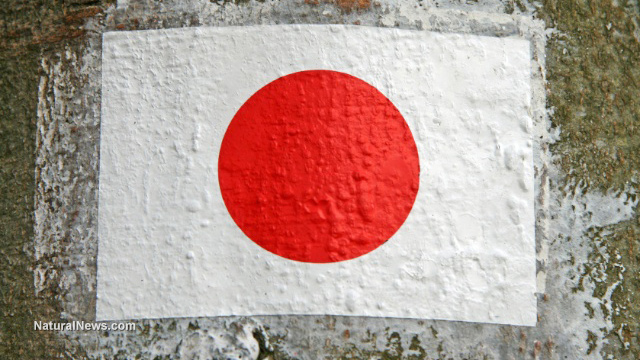Dengue fever strikes Japan for first time since 1945
Sunday, September 07, 2014 by: PF Louis
Tags: dengue fever, Japan, disease outbreak

- Newly released JFK files reveal Pentagon's role in creating Lyme disease and covid in the same lab
- Ginseng's hidden anti-aging power: How compound K is rewriting the rules of skincare
- “Endgame: The Hidden Agenda 21” unveils a world of conspiracy and control
- L.A.'s rebuilding nightmare: Only 4 permits issued after fire destroys 6,000 homes
- Scientists demand FDA withdraw mRNA COVID vaccines amid contamination and gene therapy concerns
- Senate Democrats deny censorship industrial complex existed, defend government's role in silencing dissent
- Dr. Suzanne Humphries makes bombshell appearance on Joe Rogan podcast, exposing vaccine industry deception back to POLIOMYELITIS
- Former Congresswoman exposes CCP's deep infiltration of California through universities, ports, and fentanyl
- “The shame of Minnesota”: Somali immigrants behind $250 million child nutrition fraud in largest COVID-era scam
- PROCESSED TABLE SALT in foods found to fuel depression
- Despite surge in MMR vaccination in Texas, measles outbreaks continue: Is VACCINE SHEDDING fueling the spread?
- “Independent” anti-Russia outlet MEDUZA faces COLLAPSE as US funding dries up
- Here are TEN all-natural ways to protect your garden without using harmful chemicals
- BPA: The hidden hormone disruptor sabotaging your health - and how to fight back
- Chewing gum's dirty secret: How your daily habit could be flooding your body with microplastics
- The hidden battle in your glass: How A1 and A2 milk could shape your health
- Catastrophic 7.7 earthquake devastates Myanmar and Thailand; death toll could reach 100,000
- CDC finally halts $11 billion COVID funding scam as health officials admit the ‘pandemic’ was a fraud
- Newly released JFK files reveal Pentagon's role in creating Lyme disease and covid in the same lab
- Analysis: The coming economic collapse, a mass uprising and Trump's three secret weapons to halt the growing revolt
- Festive flavors: The sweet history, nutritional profile and health benefits of pecan pie
- Elon Musk: Aliens could be here on Earth RIGHT NOW
- Trump reverses course on Gaza plan, says “nobody is expelling Palestinians”
- Big Pharma's $8 Billion bribery scheme exposed: how doctors are pushed to prescribe junk science, not heal
- Boys are back in town: Trump’s patriotic alpha crew takes the wheel while toxic females ride in the backseat
- Reclaim your health: How midlife exercise reverses years of inactivity
- A lack of integrity in Academia: Harvard professor found GUILTY of fraudulent research to promote CRT theory
- Survival 101: Effective EMF blocking techniques
- EPA advisor admits the agency is funneling billions to climate groups ahead of Trump’s return to White House
- Dr. Mike Yeadon releases 15-minute testimony - WATCH - about genocidal intent of COVID “vaccines”
- 5 Simple steps to boost your brainpower: How to strengthen executive function in a distracted world
- Florida takes a stand: DeSantis proposes permanent ban on mRNA vaccine mandates
- Sugarcane extract superior to cholesterol-lowering drugs?
- Mike Adams Sermon 66: God will DESTROY ISRAEL for its wickedness
- Pilots report mysterious lights 'moving at extreme speeds' across Oregon skies
- Space war brewing? Russia threatens to destroy Starlink satellites
- EPA advisor admits the agency is funneling billions to climate groups ahead of Trump’s return to White House
- California's social media censorship law struck down: A victory for free speech or a threat to online safety?
- The Health Ranger releases “Vaccine Zombie” song and music video, using AI-animated zombies for the music video
- Dr. Mike Yeadon releases 15-minute testimony - WATCH - about genocidal intent of COVID “vaccines”
- The pandemic as a tool for INDOCTRINATION: Understanding “The Indoctrinated Brain” by Dr. Michael Nehls
- Newly released JFK files reveal Pentagon's role in creating Lyme disease and covid in the same lab
- Florida takes a stand: DeSantis proposes permanent ban on mRNA vaccine mandates
- Mike Adams releases country western hit single: Goin’ Back in Time is Comin’ Home
- Mike Adams releases music poetry sensation: A Child of God
- “Why we influenced the 2020 elections”: Facebook files reveal the coordinated effort to bury the Hunter Biden laptop story
- Unpacking the Lies That We’ve Been Fed – new song and music video released by Mike Adams, the Health Ranger
- RFK Jr. clears key hurdle: Sen. Susan Collins backs controversial HHS nominee, signaling a new era for health policy
- Mike Adams releases new song and music video: Nothing More Disgusting Than a Globalist
- Michigan sheriff announces criminal investigation into 2020 election crimes, Dominion Voting Systems
- Israeli soldiers accused of even more torture and abuse in the West Bank
- Migrants are taking advantage of recent hurricanes to scam residents and loot their homes
- House Intelligence Committee calls for the ARREST and PROSECUTION of Dr. Anthony Fauci
- Rep. Nancy Mace introduces bill to ban biological males from female facilities on federal property
- Red Cross issues warning to stop blood plasma donations from vaccinated people
- Scientists confirm: GENIUS brain function can be spontaneously unleashed in humans without any apparent cause
- EPA advisor admits the agency is funneling billions to climate groups ahead of Trump’s return to White House
- HYSSOP: What research reveals about the health benefits of this ancient holy herb
- Two containers with completed ballots fall out of truck in Florida
- Fully vaccinated about to see “tsunami” of illness and death, warns virologist
- Global leaders unite to clamp down on “misinformation” with UN-backed Cascais Declaration
- BREAKING: 2025 NDAA authorizes mandatory military draft of WOMEN across America… as Pentagon pursues global NUCLEAR war with both Russia and China at the same time
- Michael Yon warns of a ZIONIST TAKEOVER in Trump’s second administration
- BOMBSHELL: DNA testing kits are a SCAM to develop ethnic-specific bioweapons
- Ozempic and Wegovy weight loss drugs are injectable LIZARD VENOM PEPTIDES that may unleash a devastating wave of organ failure… side effects align with symptoms of SNAKE BITES
- Israeli soldiers accused of even more torture and abuse in the West Bank
- These 13 countries just signed an agreement to engineer a global FAMINE by destroying food supply
- NASA admits that climate change occurs because of changes in Earth’s solar orbit, and NOT because of SUVs and fossil fuels
- RFK Jr. clears key hurdle: Sen. Susan Collins backs controversial HHS nominee, signaling a new era for health policy
- Sermon 30: How Jesus reveals Caesar’s FAKE CURRENCY and FALSE AUTHORITY
- Coriander seeds: Ancient medicine backed by modern science
- Arizona officials claim Maricopa County needs 10-13 days to tabulate results of the election
Unlike other mosquitoes, they bite during the day, especially around early morning and dusk. Both species are small black mosquitoes with white stripes on their back and on their legs.
Dengue (DEN-gee) fever usually affects residents of tropical and sub-tropical areas throughout the world where those types of mosquitoes readily breed. But those mosquitoes have been known to spread into more temperate regions via cargo ship transports.
All mosquitoes are attracted to stagnant collected water for breeding. During or just after a rainy season is when mosquito habitats flourish with their eggs that soon release more mosquitoes.
This appears to be what happened in Central Tokyo's Yoyogi Park, a large and popular park that attracts tourists and locals abundantly during daylight hours. Until now, dengue fever has been under control, even as the Asian tiger mosquito continues to be endemic to Japan.
It's Yoyogi Park that's been heavily infested with these daylight blood suckers. All 34 recently stricken with dengue during this breakout had visited that park just prior to showing signs of dengue fever.
About dengue fever and possible remedies
According to the WHO (World Health Organization), 22,000 people die annually from complications of dengue fever. One wonders how WHO statistics remain the same for each year. The mortality rate is around one percent with typical dengue fever, which is a painful and debilitating affliction accompanied by flu symptoms and high fever.But mortality increases to up to 20 percent with dengue hemorrhagic fever (DHF), a variation or complication that tends to mostly affect children under 10 years of age and older people. It causes abdominal pain, hemorrhage (bleeding) and circulatory collapse (shock).
What's weird is that DHF may set in shortly after the fever's decline. Dehydration and internal bleeding are part of DHF's disease symptom package, which is similar to Ebola.
There is "officially" no specific pharmaceutical treatment for either form of dengue fever, and it takes time to recover fully without weakness. But a non-pharmaceutical antiviral extract of black elderberry proved to be much more efficient at handling the swine, or any other, flu than pharmaceutical Tamiflu.
Elderberry doesn't cause side effects, while the side effects from Tamiflu were so bad that it was banned in Japan. Raw elderberry plants contain a poisonous compound related to cyanide, so one should be careful to use a reliable, safe preparation from a known provider. While elderberry hasn't been tested for effects in regard to dengue infections, it does have antiviral and antioxidant properties which may help improve one's health.
Meanwhile, health officials cite progress in vaccine developments, just what mainstream medicine needs to further gamble with peoples' lives, "protection" that may harm more than help. Other ignored solutions include mega-dose IV vitamin C or the more easily accessed oral liposomal vitamin C.
Mega-dose vitamin C in either form, the latter being more convenient and less expensive, has yet to come across a viral infection that it couldn't handle, from the flu to viral pneumonia to polio, even among some on life support. But the medical mafia doesn't want you to know that.
Preventive measures
As with all mosquito infestations, they are best nipped in the bud. In Mexico, it was common for health agency volunteers to come to homes after a monsoon, especially in rural areas, to peek into ponds and open air containers to find and destroy mosquito larvae in the water.Here in the states and elsewhere, it's more common for trucks to drive around residential areas with trucks spraying insecticides that are harmful to people and pets. To be sure, Yoyogi Park has been blanketed with insecticides since the Tokyo breakout.
Controlling collected water in open spaces or containers is the best approach for keeping the mosquito populations down. But it's the most difficult to enforce. Not everyone is willing to be so diligent with collected water. Stocking ponds with fish who feed on mosquito larvae helps, and it's easy.
Sources for this article include:
http://www.cdph.ca.gov
http://www.theguardian.com
http://www.medicinenet.com
http://www.who.int
http://umm.edu
http://science.naturalnews.com
Dengue fever at FETCH.news
Get independent news alerts on natural cures, food lab tests, cannabis medicine, science, robotics, drones, privacy and more.
Take Action: Support Natural News by linking to this article from your website
Permalink to this article:
Embed article link: (copy HTML code below):
Reprinting this article:
Non-commercial use OK, cite NaturalNews.com with clickable link.
Follow Natural News on Facebook, Twitter, Google Plus, and Pinterest
Science News & Studies
Medicine News and Information
Food News & Studies
Health News & Studies
Herbs News & Information
Pollution News & Studies
Cancer News & Studies
Climate News & Studies
Survival News & Information
Gear News & Information
News covering technology, stocks, hackers, and more



"Big Tech and mainstream media are constantly trying to silence the independent voices that dare to bring you the truth about toxic food ingredients, dangerous medications and the failed, fraudulent science of the profit-driven medical establishment.
Email is one of the best ways to make sure you stay informed, without the censorship of the tech giants (Google, Apple, Facebook, Twitter, YouTube, etc.). Stay informed and you'll even likely learn information that may help save your own life."
–The Health Ranger, Mike Adams













































